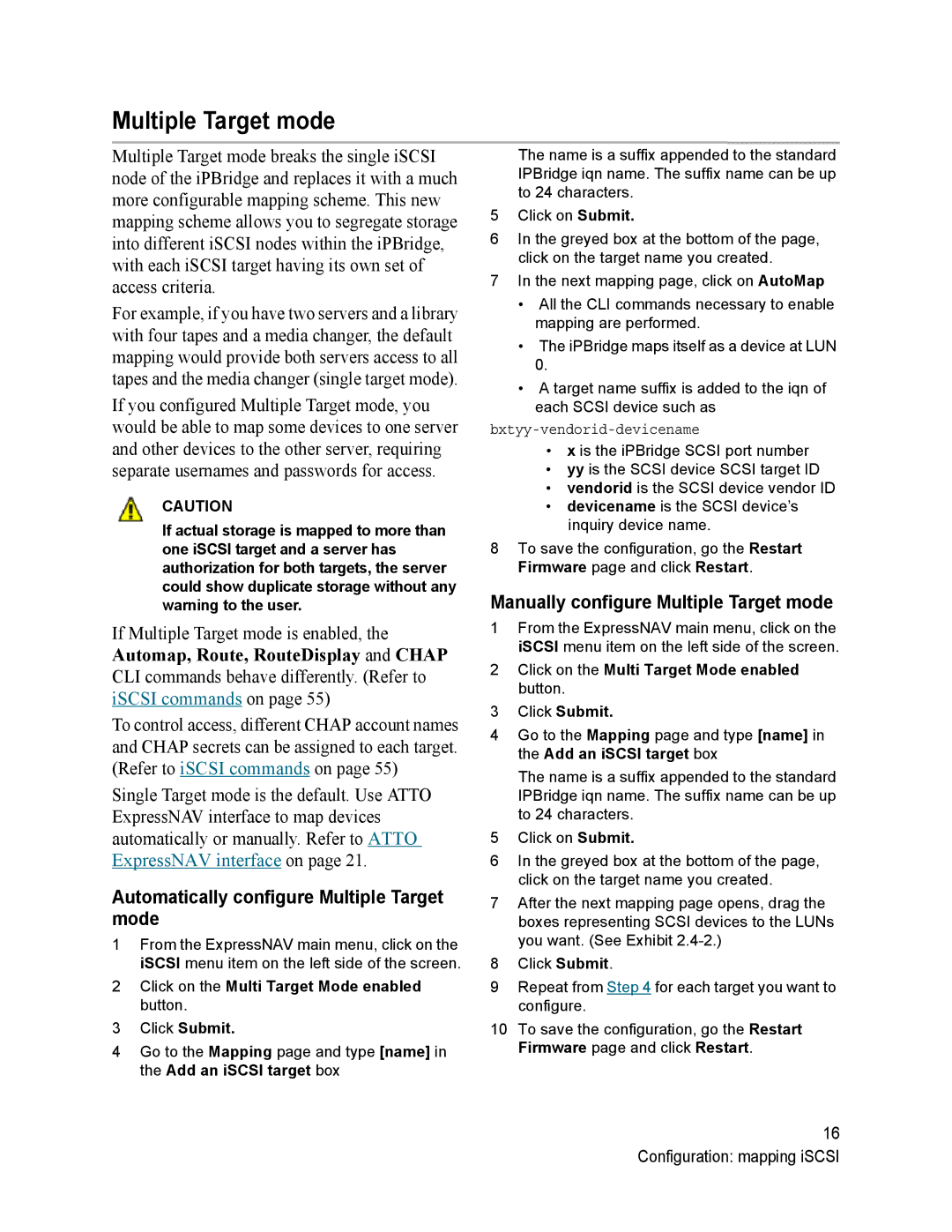
Multiple Target mode
Multiple Target mode breaks the single iSCSI node of the iPBridge and replaces it with a much more configurable mapping scheme. This new mapping scheme allows you to segregate storage into different iSCSI nodes within the iPBridge, with each iSCSI target having its own set of access criteria.
For example, if you have two servers and a library with four tapes and a media changer, the default mapping would provide both servers access to all tapes and the media changer (single target mode).
If you configured Multiple Target mode, you would be able to map some devices to one server and other devices to the other server, requiring separate usernames and passwords for access.
CAUTION
If actual storage is mapped to more than one iSCSI target and a server has authorization for both targets, the server could show duplicate storage without any warning to the user.
If Multiple Target mode is enabled, the Automap, Route, RouteDisplay and CHAP CLI commands behave differently. (Refer to iSCSI commands on page 55)
To control access, different CHAP account names and CHAP secrets can be assigned to each target. (Refer to iSCSI commands on page 55)
Single Target mode is the default. Use ATTO ExpressNAV interface to map devices automatically or manually. Refer to ATTO ExpressNAV interface on page 21.
Automatically configure Multiple Target mode
1From the ExpressNAV main menu, click on the iSCSI menu item on the left side of the screen.
2Click on the Multi Target Mode enabled button.
3Click Submit.
4Go to the Mapping page and type [name] in the Add an iSCSI target box
The name is a suffix appended to the standard IPBridge iqn name. The suffix name can be up to 24 characters.
5Click on Submit.
6In the greyed box at the bottom of the page, click on the target name you created.
7In the next mapping page, click on AutoMap
•All the CLI commands necessary to enable mapping are performed.
•The iPBridge maps itself as a device at LUN 0.
•A target name suffix is added to the iqn of each SCSI device such as
bxtyy-vendorid-devicename
•x is the iPBridge SCSI port number
•yy is the SCSI device SCSI target ID
•vendorid is the SCSI device vendor ID
•devicename is the SCSI device’s inquiry device name.
8To save the configuration, go the Restart Firmware page and click Restart.
Manually configure Multiple Target mode
1From the ExpressNAV main menu, click on the iSCSI menu item on the left side of the screen.
2Click on the Multi Target Mode enabled button.
3Click Submit.
4Go to the Mapping page and type [name] in the Add an iSCSI target box
The name is a suffix appended to the standard IPBridge iqn name. The suffix name can be up to 24 characters.
5Click on Submit.
6In the greyed box at the bottom of the page, click on the target name you created.
7After the next mapping page opens, drag the boxes representing SCSI devices to the LUNs you want. (See Exhibit
8Click Submit.
9Repeat from Step 4 for each target you want to configure.
10To save the configuration, go the Restart Firmware page and click Restart.
16 Configuration: mapping iSCSI
